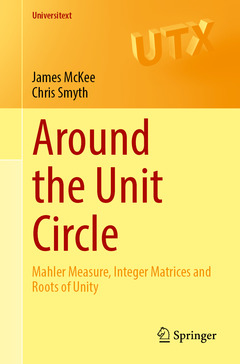Around the Unit Circle, 1st ed. 2021 Mahler Measure, Integer Matrices and Roots of Unity Universitext Series
Auteurs : McKee James, Smyth Chris

One way to study algebraic integers is to associate them with combinatorial objects, such as integer matrices. In some of these combinatorial settings the analogues of several notorious open problems have been solved, and the book sets out this recent work. Many Mahler measure results are proved for restricted sets of polynomials, such as for totally real polynomials, and reciprocal polynomials of integer symmetric as well as symmetrizable matrices. For reference, the book includes appendices providing necessary background from algebraic number theory, graph theory, and other prerequisites, along with tables of one- and two-variable integer polynomials with small Mahler measure. All theorems are well motivated and presented in an accessible way. Numerous exercises at various levels are given, including some for computer programming. A wide range of stimulating open problems is also included. At the end of each chapter there is a glossary of newly introduced concepts and definitions.
Around the Unit Circle is written in a friendly, lucid, enjoyable style, without sacrificing mathematical rigour. It is intended for lecture courses at the graduate level, and will also be a valuable reference for researchers interested in Mahler measure. Essentially self-contained, this textbook should also be accessible to well-prepared upper-level undergraduates.
Chris Smyth, a professorial fellow in Number Theory at the University of Edinburgh, has a long-standing interest in Mahler measure. This dates from his PhD thesis, where he studied Lehmer’s conjecture for nonreciprocal integer polynomials. He discovered the first known closed formula for a 2-dimensional Mahler measure involving an L-function, leading to a deep study of such formulae by Boyd, Deninger, Rodriguez Villegas and others. He invented the explicit auxiliary function method, which applies semi-infinite linear programming to number-theoretic problems, including to the Mahler measure of totally real polynomials.
A thorough introduction to the combinatorial approach to Mahler measure and more
Presents results that have not previously appeared in book form
Includes new tables of small Mahler measures and limit points
Appendices on prerequisites make the book self-contained
Date de parution : 12-2021
Ouvrage de 438 p.
15.5x23.5 cm
Thème d’Around the Unit Circle :
Mots-clés :
Mahler measure; Lehmer's problem; Schinzel-Zassenhaus conjecture; Textbook on applications of graph theory to number theory; adjacency matrix; Estes-Guralnick conjecture; Robinson's conjecture; Cyclotomic integers; Auxiliary function methods; Schur-Siegel-Smyth trace problem; Symmetrizable integer matrics; Signed and directed graphs; Salem numbers



